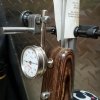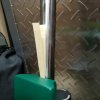The Tubbs bullets won't hurt. But as described in the Tubbs instructions, just use the last two or three sets and not the course ones.
Given your description of the problem, I really think you should give that bedding a much closer look. Try testing it with a dial gauge. Since you didn't mention doing that, I assume you don't know how or don't have access to the equipment. Please forgive me if I'm wrong.
Remove the center screw completely. Then mount the dial gauge on the barrel with the indicator touching the bottom of the forend. Make sure the dial moves when you squeeze the barrel and forend together and when you pull them apart. Stand the rifle on its butt pointing straight up and hold it by the forend. Now tighten and loosen the front screw with the rear screw tight watching for dial gauge movement. Repeat the same process with the rear screw. Now leave both front and rear tight and install and then tighten and loosen the center screw watching the dial gauge. Any movement in the dial gauge more than a thou and a half during any of the three sequences indicates stress in the bedding.
I don't generally like YouTube videos, but this one shows the general method. I greatly favour standing the rifle on its butt, I don't use a barrel vice, and I have a barrel clamp for the indicator instead of a magnetic holder. I tried and failed at inserting a photo of my setup.
If you don't have a dial gauge, some people can see and/or feel the movement with a very light touch of your forefinger on the joint between the barrel and forend. I've also successfully used a long 6 inch X 1/4 inch strip of heavy paper cut from a file folder folded in half like a 3" long "V" with the fold inserted into the gap between the forend and barrel. The ends of the paper will magnify any movement in the gap.
I love wood, but it is very sensitive to bedding problems and usually benefits from properly installed pillars. Really gorgeous fancy wood is the worst of all because of how much it moves with temperature and humidity. I have an old rifle with a hand made presentation grade Claro walnut stock that was so bad that I eventually milled it out and epoxyed in a bedding block. It is still beautiful, but it doesn't move anymore....


